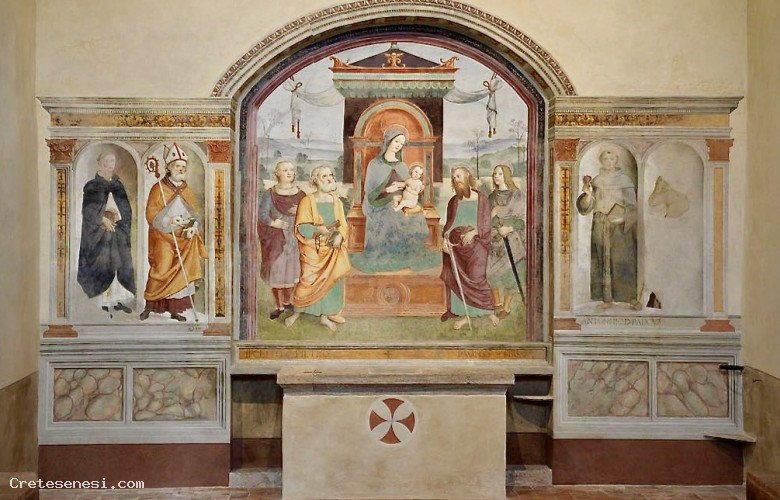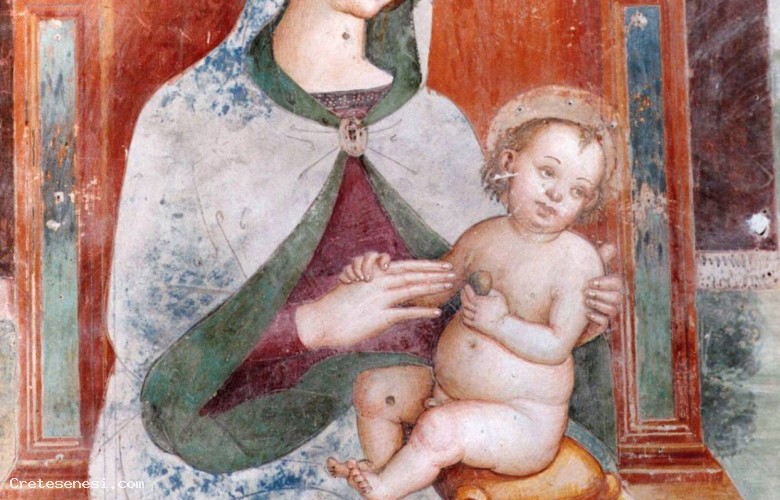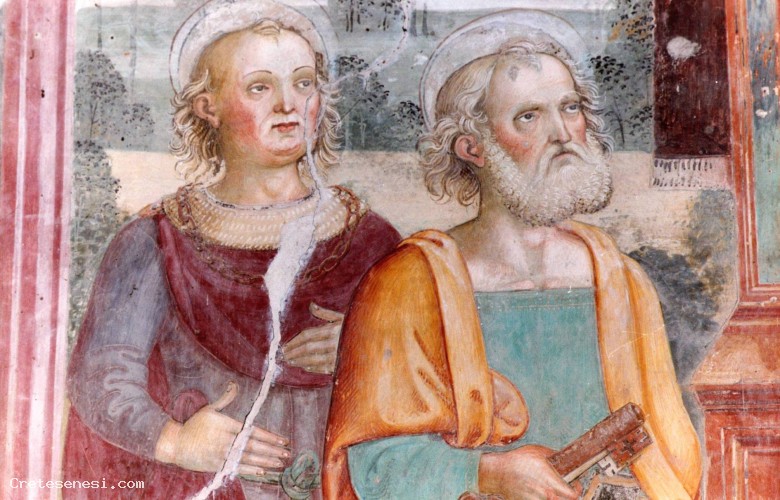Churches
Pieve di Sant'Ippolito
ASCIANO LISTEN THE AUDIO GUIDE
LISTEN THE AUDIO GUIDE





.jpg)


Time table
For visit the church, contact the property via email to: chiesasantippolito@email.itThe Pieve of Saint Hippolytus is the oldest church in Asciano, cited in 714 in a quarrel between the bishops of Siena and Arezzo, but it probably dates back to the fourth century A. D. Its original structure had three naves, but now it has just one. At one end of the nave the entire wall is decorated with a splendid fresco that already at the beginning of the nineteenth century was attributed to the Siennese artist Giacomo Pacchiarotti. The fresco consists of an enthroned Madonna and Child with Saints Peter, Paul, Hippolytus, and Cassius.
Of this beautiful fresco, executed in multiple hands, as it is clear, even from a direct view, is quite certain attribution to Umbrian artists. According to recent studies, in fact, Our Lady with Child, might be in the hand of the Pinturicchio. But what strikes at first sight is the adolescent and refined face of the young Sant'Ippolito, with cloak and sword, the only one who turns to the observer.
Well from the overlapping of somatic traits, between this face and some self-portraits denotes the somewhat amazing resemblance to Raffaello; Just look at the shape of the eyes, the contour of the nose, the chin line or the contour of the face. But why a so fine fresco, in a small province church? The presence of Raffaello in Siena is documented, as Pinturicchio invited Raffaello, though seventeen but already magister, to collaborate in the frescoes of the Piccolomini Library, inside the Duomo of Siena.
That is why the study of the Lauretane paths (roads leading to Loreto and of which one of them passes by Asciano) allowed them to be executed in the year of the Great Millennium Jubilee, in the year 1500. The presence of the two Saints Peter and Paul, symbols of Christianity, would in fact confirm a commission from Rome, from the Vatican institutions, to the completion of various initiatives of embellishment and enrichment of sacred places.
But another discovery tells us to the author: on the dark collar of the figure of Sant'Ippolito, it is possible to clearly read the R and A and, observing more closely, the visible P, H and V are also visible Behind a lock of hair to make up the famous RAPH signature. V. (in Latin RAPHAEL URBINAS).
The Pieve of Saint Hippolytus is the oldest church in Asciano, cited in 714 in a quarrel between the bishops of Siena and Arezzo, but it probably dates back to the fourth century A. D. Its original structure had three naves, but now it has just one. At one end of the nave the entire wall is decorated with a splendid fresco that already at the beginning of the nineteenth century was attributed to the Siennese artist Giacomo Pacchiarotti. The fresco consists of an enthroned Madonna and Child with Saints Peter, Paul, Hippolytus, and Cassius.
Of this beautiful fresco, executed in multiple hands, as it is clear, even from a direct view, is quite certain attribution to Umbrian artists. According to recent studies, in fact, Our Lady with Child, might be in the hand of the Pinturicchio. But what strikes at first sight is the adolescent and refined face of the young Sant'Ippolito, with cloak and sword, the only one who turns to the observer.
Well from the overlapping of somatic traits, between this face and some self-portraits denotes the somewhat amazing resemblance to Raffaello; Just look at the shape of the eyes, the contour of the nose, the chin line or the contour of the face. But why a so fine fresco, in a small province church? The presence of Raffaello in Siena is documented, as Pinturicchio invited Raffaello, though seventeen but already magister, to collaborate in the frescoes of the Piccolomini Library, inside the Duomo of Siena.
That is why the study of the Lauretane paths (roads leading to Loreto and of which one of them passes by Asciano) allowed them to be executed in the year of the Great Millennium Jubilee, in the year 1500. The presence of the two Saints Peter and Paul, symbols of Christianity, would in fact confirm a commission from Rome, from the Vatican institutions, to the completion of various initiatives of embellishment and enrichment of sacred places.
But another discovery tells us to the author: on the dark collar of the figure of Sant'Ippolito, it is possible to clearly read the R and A and, observing more closely, the visible P, H and V are also visible Behind a lock of hair to make up the famous RAPH signature. V. (in Latin RAPHAEL URBINAS).